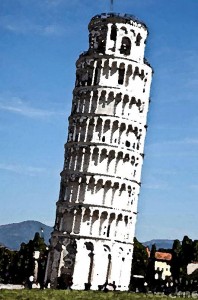“But what’s my second-best Tone? Which way do I “lean”?

This one comes up over and over and over again. It’s not hard to see why, because most of us at some point compromise and buy things that aren’t strictly harmonious with our TCI 12 Tone palette, but how valid is this notion? Is it possible in SciARTTCI 12-Tone practice to routinely recommend a “runner up” tone?
My short answer is that I don’t believe the concept of second-best is generally helpful, after all PCA’s claim to fame has never been ‘find your second best colours’ – but in saying that, the situation is more complex and ultimately much more interesting than a quick generalisation allows.
As always, following the reasoning for this depends on an understanding of the way colour and the 12-Tones are defined in terms of three dimensions – hue, value, and chroma. The first thing to note is that the tones are not simple wedges, paths, or slices through colour space, like segments of an orange – each is a complex, dimensional concept and can be thought of as consisting of a series of related domains within the parameters of hue, chroma, and value.
In more concrete terms, if we could highlight each tone individually in an imaginary, translucent, “colour solid” we would see that the “zones” belonging to a given tone form a three dimensional pattern of shapes in space, related by the tones’ governing characteristics (we might pick out the areas of the colour solid that are warm, muted and of medium value, for example, in the case of True Autumn). Each tone in this abstract “world” of colour space would show up as a series of unique shapes, like pieces of a 3D puzzle with no two pieces the same.
The first important point I’m trying to make with this rather abstract idea is that the tones all have their own individual design and form in colour space, just as islands, continents and countries have different and unique shapes on the globe. The second essential thing I want you to get from this tricky bit of theory is that each tone is “bordered” by equally complex, interlocking sets of areas that belong to other tones, just as the individual pieces in our complicated 3D puzzle all fit together in way more complex form than do slices of cake.

These organic differences between the “tonal shapes” of one tone and another, even between tones in the same parent season (that is, the winters, the springs and so on) or a similar hue temperature family (for example, the purely cool – True Winter, True Summer, and the warm neutrals – Bright and Light Spring, Dark and Soft Autumn) are not just a matter of a “jump to the left and a step to the right”. In other words, we don’t move from one palette to another by simply “changing key” and shifting the whole thing lighter or darker or warmer or cooler or whatever – each tone is like an individual tune, and has a specific architecture based on all three dimensions of colour.
You can no more move from a Winter palette “map” to a Summer one with a simple change of one dimension than you can turn one model of car into another with nothing more than a bit more grey in the paint job. We don’t turn into someone else just because our hair and lipstick are lighter and darker – our face and body architecture also matters and there is really no denying our essential form. And so it is with the 12 Tones.
Let’s go back to our question, now. You may well do pretty well in carefully chosen “off-piste” colours outside your tonal home, but the selection criteria for how you might best do this is unlikely to be quite as simple as “Ok, you’re a Light Summer, but you can also wear the True Summer palette”, because the two spaces are different. It’s true that you may do a lot better this way than trying on something completely unrelated, such as True Spring (for example), and indeed some schools of PCA teach students to graze among their neighbouring “Seasonal” tones like this, but the reality for most is almost certainly going to be more nuanced and intricate.
What most experienced palette users tend to do, when compromising in real life, is to push into other palettes in what may on casual inspection look like random fashion that depends on their personal tastes, preferences, and needs. But often something more complicated is going on, and they’re actually making some finely judged calls based on how their tone approaches others in colour space, and choosing these compromises based how they like to wear their palette, their favourite colours generally, and in light of what is available.
If we look at the wardrobe of a Soft Summer member of my own household, you’ll see a lot of close harmony with the actual palette, but also things like a jumper (that’s a sweater, here, for those in North America) that’s more DA claret than SSu burgundy, a pair of jeans more Light or True Summer in their blueness, a spruce green or sage shirt that’s probably closer to SA, and a pair of board shorts that wouldn’t upset a DW – and you might be hard pressed to say which of these compromises works better (or not) as *all* of them are close enough for going on with in some fashion – neutral enough, muted enough, cool enough or whatever. As Meatloaf once sang, two out of three ain’t bad, especially when choices are limited and we can’t let the perfect be the enemy of the good.

The other thing that influences compromise direction is the simple fact that clothing ranges still tend to trend to particular palettes for given values of style. A Soft Summer looking for a preppy or corporate or gamine look, for example, might find themselves eyeing Dark Winter, True Summer or Light Summer options in order to get the cool crisp lines and tailoring qualities they’re after, while the same person, keen on Landcare and bushwalking, might have trouble finding hiking gear outside of the neutral Autumns’ fashion neutrals, or exercise wear that isn’t True Summer’s pinks and purples, or True or Bright Winter’s. They will accept something that isn’t as flattering to their skin tone as it might be because other priorities are coming to bear on their choices, too.
Further, one person might find the slightly wan, whitened and tightened look of too-cool the lesser evil while their colour twin might prefer the faint yellowing and hazing of something a bit too warm (these effects aren’t meant to be universal generalizations by the way, but to suggest the way different people might view a compromise). Finally, if you prefer your darks or your lights or have a preference for your neutrals, or crave a bit more saturation or a bit less in your accents, then these tropes can also nudge you one way or the other (note that to some extent the TCI corporate palettes can extend your range a little here as well).
When we stop thinking of the palettes as simple blocs of colour and start seeing them as sitting in colour space in organic, interlocked fashion, these apparent contradictions make a lot more sense. In a previous article, When The Tonal Lines Blur, we discussed how different tones can approach each other closely at their boundaries; when we realize how intricate the map actually is, it is less surprising that many individuals “cheat” in different directions, though ideally not all at once. A little disharmony can be stimulating and interesting (for more discussion of this idea, see previous articles “Is Disharmony Ever Desirable” and “Breaking Bad“: Part V), but throw too much in the mix and things can start feeling chaotic, generally the very thing that we came to PCA to avoid.
Astute readers will have already realized that this structural tonal complexity is a major reason why many people, especially neutral types (most of us) can find it so difficult to locate a colour home on their own – an awful lot of things seem to work in SOME way, while not much ever seems to hit that pitch-perfect sweet spot where the colour and style harmonies fuse. Working out the common message is not always easy, and no matter how good the colour and style advice you get is, you are always going to have to do some yards to qualify it with your own tastes, needs, and budget and so on, and make it truly yours. (And if you are a standard fit between 5’3 and 5’7” and a B to C cup, you are right where the industry wants you and – in theory – have the best odds out there in the shops, but those much outside the fitting-model standard can find this process very hard indeed.)
Finally, because we can’t show you absolutely everything in a draping, it is easy to over-generalize about a “second best tone” on the basis of a sampling of colours which, strictly speaking, aren’t “your” tone but which none the less connect on “two out of three” axes of colour. As we’ve seen, it’s a bit more complicated than that for most of us.
In draping, we aim to educate your eye, show you your optimal tonal home, and help you to make deliberate and knowing choices about colour. In real life, however, time, experience, personality, preference and your own eye will tell you if and where you can push it out a little.
In The Leaning Toner Part II we will investigate the idea of leaning within a tone.
